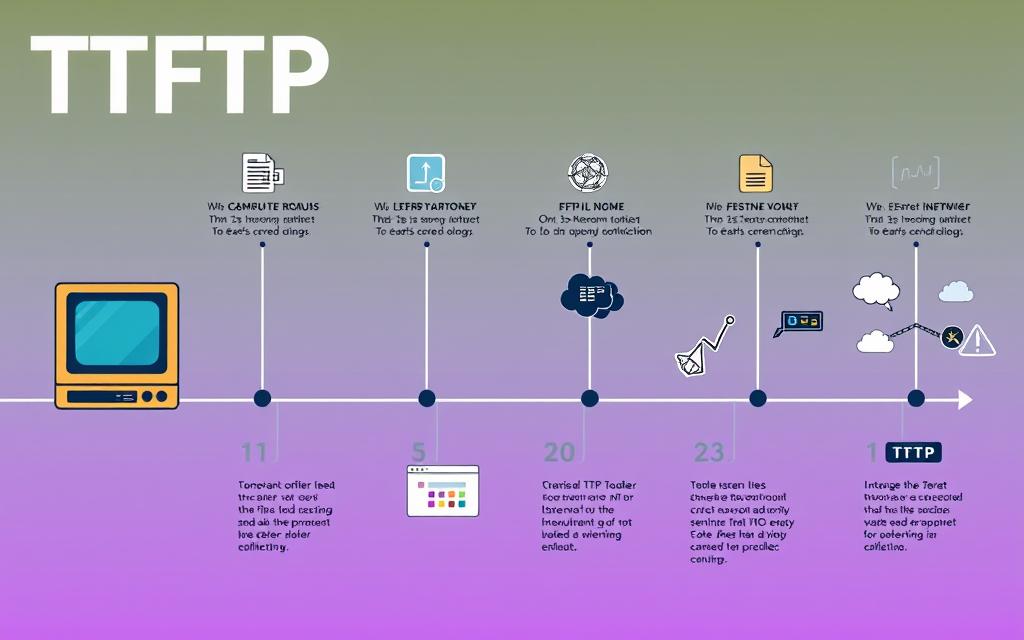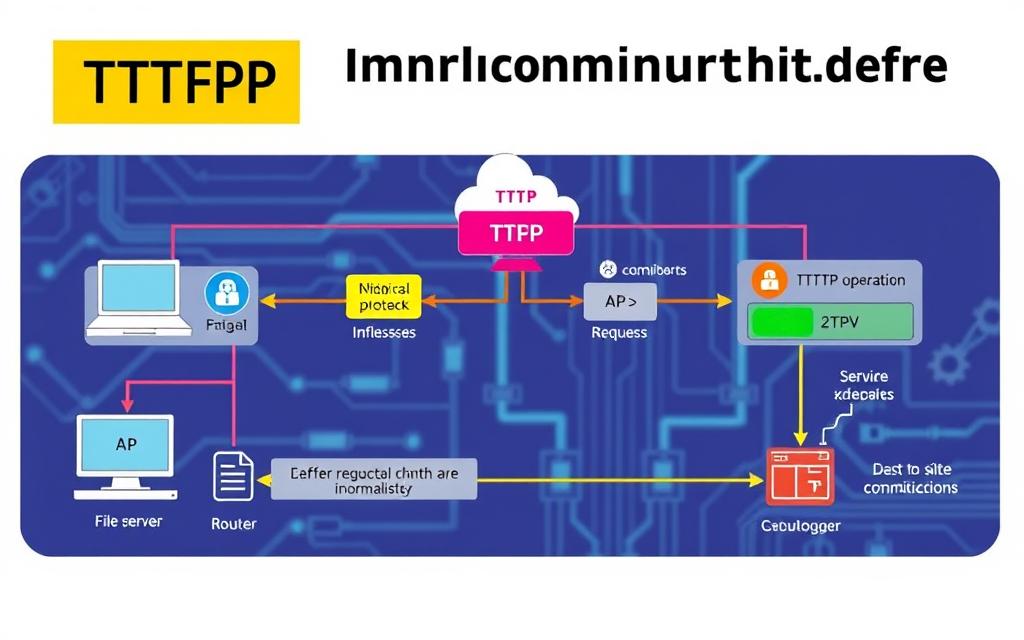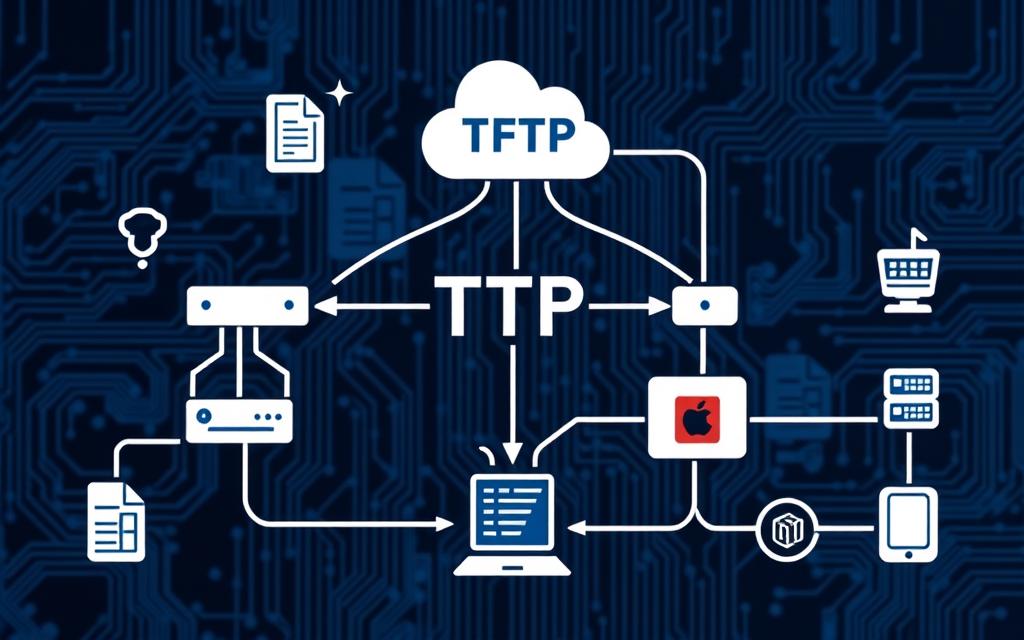What Is TFTP in Computer Networks? A Simple Guide
TFTP, or Trivial File Transfer Protocol, is key in computer networks for file sharing. It uses UDP for fast data transfer, making it great for local networks. But, it lacks security, so it’s best used in private areas where risks are low.
This protocol is easy to use and doesn’t need much coding. It’s perfect when you don’t need to check who’s sending the files.
TFTP is great for downloading important files like operating systems and setup files. It works by sending data in blocks and checks if it’s received correctly. Knowing TFTP is vital for anyone working in network administration, helping you grow in your career.
Understanding TFTP: The Basics of Network File Transfer
TFTP, or Trivial File Transfer Protocol, is a simple way to move files over a network. It uses port 69 and UDP for fast transfers. This makes it great for moving small files like boot files and firmware images.
Unlike FTP, TFTP is easy to use but lacks security. It’s perfect for quick transfers of files in networked devices. This is because it needs less memory and is simple to set up.
TFTP is known for its speed, simplicity, and low memory use. It’s often used for updating firmware and transferring config files. Many network devices, like routers and switches, support TFTP.
What Makes TFTP Different from FTP
TFTP and FTP differ in several ways. TFTP uses UDP, while FTP uses TCP. TFTP also doesn’t have security features or error-checking. But, it’s faster and simpler, making it better for small files.
Core Features of TFTP
TFTP’s main features include UDP transport and fixed-size data blocks. It also lacks security features. Its simplicity makes it a top choice for updating firmware and transferring config files.
When to Use TFTP
TFTP is best for small files like boot files and firmware images. It’s also great for updating firmware and transferring config files. Its speed, simplicity, and low memory use make it a popular choice.
The Historical Evolution of TFTP in Computer Networks
The Trivial File Transfer Protocol (TFTP) started in 1981 with RFC 783. It has grown a lot, becoming a key part of computer networks. Its simplicity and speed make it great for quick file transfers.
TFTP was made to be simple, unlike other FTPs. It uses UDP (port 69) for transfers, unlike TCP. This makes it fast but less reliable. It’s now used for quick setup of devices on networks.
TFTP sends data in blocks of 512 bytes. It uses 16-bit sequence numbers for each block. It’s not secure for the internet because it lacks encryption and authentication. Yet, it’s common in local networks.

TFTP has evolved for use in PXE boot and network device settings. Its ease and speed make it ideal for boot files and firmware updates. It will likely stay important in local networks, even with its security issues.
| TFTP Feature | Description |
|---|---|
| Transport Protocol | UDP (port 69) |
| Data Transfer | Block by block, with each block consisting of 512 bytes |
| Security | Lacks integrated security elements like encryption and authentication |
In summary, TFTP’s history and growth are linked to its role in computer networks. Its role in various tasks is clear. But, we must think about its security to ensure safe file transfers.
How TFTP Functions in Modern Networks
In today’s networks, TFTP is key for file transfers when full FTP isn’t needed. Its simple and fast design makes it great for UDP file transfers. The TFTP protocol is light and easy to use.
TFTP has five packet types: read and write requests, data, acks, and error packets. It uses stop-and-wait mode for reliable data transfer. This makes it work well in modern networks.
TFTP supports both ASCII and binary transfer modes. It also has a stop-and-wait error recovery. This makes TFTP efficient, reliable, and easy to use. It’s a top pick for many applications.
Key Components of TFTP Implementation
The TFTP system uses a client-server setup for file sharing. This setup is key to its success. It relies on User Data Protocol (UDP) to work over Internet Protocol (IP). This is different from FTP, which uses TCP.
TFTP’s packet design is another important part. Each data packet is 516 bytes, with 8 bytes from UDP headers. This design helps files move across networks. There are five types of packets: Read Request (RRQ), Write Request (WRQ), Data, Acknowledgment (ACK), and Error packets. Each has its own role in transferring files.
Some of the main parts of TFTP include:
- Client-Server Architecture: Enables file transfer between devices.
- UDP: Allows TFTP to operate on IP, differing from FTP’s use of TCP.
- Packet Structure: TFTP data packets are 516 bytes long, with 8-byte UDP headers.
- TFTP Packets: Five types – RRQ, WRQ, Data, ACK, and Error packets, each with a specific role.
TFTP implementation becomes clearer when you understand these components. The key components of TFTP, like its architecture and packet design, are vital. Knowing these basics helps us see TFTP’s importance in network file transfers and its benefits.

Common Applications and Use Cases of TFTP
TFTP applications are widely used in many scenarios. These include network device configuration and firmware updates. The simplicity and efficiency of TFTP make it perfect for these tasks. For example, TFTP is often used for updating firmware in home routers and distributing software in corporate networks.
Some of the key use cases of TFTP include:
- Network device configuration: TFTP is used to configure and manage network devices, such as routers and switches.
- Firmware updates: TFTP is used to update the firmware of network devices, ensuring they remain secure and up-to-date.
- Boot file distribution: TFTP is used to distribute boot files to devices, allowing them to boot from a central server.
These use cases show how vital TFTP is for managing and maintaining network devices. Its simplicity and efficiency make it a key tool for network administrators. 
Aside from these, TFTP is also used in network booting. Here, a computer loads and starts its operating system from a central server. This use of TFTP shows its versatility and importance in today’s networks.
TFTP has become an essential protocol in modern networks, providing a simple and efficient way to manage and maintain network devices.
TFTP Security Considerations and Best Practices
Using TFTP raises important security concerns. It lacks authentication and encryption, making it risky for sensitive data. Yet, it’s okay for simple file transfers in safe environments.
Some key considerations for TFTP security include:
- Use TFTP only for non-sensitive data transfers
- Implement additional security measures, such as firewalls and access controls
- Use alternative protocols, like SFTP or FTPS, for secure file transfers
| Best Practice | Description |
|---|---|
| Limit TFTP access | Restrict TFTP access to authorized personnel and devices |
| Monitor TFTP activity | Regularly monitor TFTP activity to detect possible security threats |
| Use secure protocols | Use secure protocols, like SFTP or FTPS, for sensitive data transfers |
By following these best practices and thinking about security, you can have a safe and effective TFTP experience.
Setting Up and Configuring TFTP Servers
To set up a TFTP server, you need to follow a few key steps. This ensures the process is smooth and efficient. TFTP servers are used for quick file transfers, which is vital for updating network devices like routers and switches.
Configuring a TFTP server involves several important aspects. These include installation steps, configuration parameters, and troubleshooting guidelines. For example, setting one up on Windows 10 means downloading software like SolarWinds Free TFTP Server. You also need admin rights and a folder for storing files.
Key Configuration Parameters
Important settings for TFTP servers include IP address restrictions and file transfer control. You can also use server bindings to boost security based on your network interfaces. It’s also key to secure your TFTP server to prevent unauthorized access and protect data integrity.
When troubleshooting, it’s vital to spot common issues like connectivity problems or file transfer errors. A structured troubleshooting approach helps administrators fix problems quickly. This ensures the TFTP server works as it should.
TFTP Server Setup Best Practices
Here are some best practices for setting up TFTP servers:
- Use a secure protocol for file transfers
- Limit access to the TFTP server to authorized users only
- Keep the TFTP server software up to date with the latest security patches
- Watch for any suspicious activity or errors on the TFTP server
By sticking to these best practices and configuring the TFTP server carefully, administrators can ensure secure and efficient file transfers. This meets the needs of their organization.
Comparing TFTP with Other File Transfer Protocols
There are many ways to move files over a network. Each method has its own good points and downsides. Looking at TFTP against FTP and SFTP can help pick the right one for you.
FTP is often seen as more dependable because it uses TCP. This means files usually get to where they’re meant to go. But, FTP can be slower, which is a problem for big files or long distances. TFTP, on the other hand, is quicker because it uses UDP. Yet, it doesn’t have FTP’s reliability features.
Key Differences Between TFTP, FTP, and SFTP
- TFTP: fast, simple, and good for local transfers, but not secure or reliable
- FTP: reliable, secure, and works well over long distances, but slower and more complicated
- SFTP: secure, reliable, and good for long distances, but slower and more complicated than TFTP
Comparing TFTP to SFTP shows SFTP is safer because it encrypts data. FTP sends data openly, which is less safe. Think about your files’ size, how sensitive they are, and your network’s security needs when choosing.
In summary, comparing TFTP with other protocols helps you decide wisely. Knowing each protocol’s strengths and weaknesses lets you pick the best for your needs. This ensures your files are transferred securely and efficiently.
| Protocol | Speed | Security | Reliability |
|---|---|---|---|
| TFTP | Fast | Low | Low |
| FTP | Medium | Medium | High |
| SFTP | Medium | High | High |
Future Developments and Trends in TFTP Usage
The future of TFTP looks bright with new developments and trends. We can expect better security and faster speeds. The Internet of Things (IoT) will also influence TFTP’s future.
Cloud services and the need for quick, secure transfers are key trends. Developers are adding enhanced authentication and encryption methods. These updates will keep TFTP safe and reliable for file transfers.
Here are some key developments and trends for TFTP’s future:
- Increased use of cloud-based services
- Growing demand for faster and more secure file transfer protocols
- Emergence of new technologies, such as the Internet of Things (IoT)
- Development of new features and improvements, such as enhanced authentication and encryption methods
Keeping up with TFTP’s evolution is vital. This ensures the use of the most secure and efficient protocols. The future of TFTP is exciting, and it will be interesting to see how it continues to shape the world of network file transfer.
In conclusion, the future of TFTP is full of possibilities. Ongoing developments and trends will shape its usage. TFTP will remain a key player in network file transfer, thanks to its simplicity and efficiency.
| TFTP Feature | Description |
|---|---|
| Simple Lock-Step Protocol | Limits throughput, but provides a simple and efficient way to transfer files |
| Lack of Authentication | Does not provide authentication, making it less secure than other protocols |
| Small Memory Footprint | Requires minimal system resources, making it a popular choice for embedded systems |
Conclusion: Embracing TFTP in Your Network Infrastructure
Trivial File Transfer Protocol (TFTP) is a key part of today’s computer networks. It’s simple, efficient, and very useful. Network admins and IT pros rely on it for many tasks.
TFTP helps with setting up network devices, updating firmware, and booting diskless systems. It makes these tasks easier and improves network reliability.
The importance of TFTP will only grow as technology advances. Using TFTP wisely can make your network work better. It simplifies file transfers and reduces complexity.
Think about adding TFTP to your network management plans. Use it alongside other protocols to get the most out of your network.
Success with TFTP comes from staying up-to-date and keeping your network secure. Tailor TFTP to fit your needs. This way, your network will stay strong and effective for the future.
FAQ
What is TFTP and why is it important in computer networks?
TFTP stands for Trivial File Transfer Protocol. It’s a simple way to move files around in computer networks. It’s great for setting up devices, updating firmware, and sharing boot files because it’s easy and quick.
How does TFTP differ from other file transfer protocols like FTP?
TFTP is much simpler than FTP. It uses UDP and doesn’t have security features like FTP does. This makes it good for small files in slow networks but not as safe as FTP or SFTP.
What are the core features and use cases of TFTP?
TFTP is known for its simplicity and lack of security. It’s used for setting up devices, updating firmware, and sharing boot files. Its ease of use makes it a top choice for these tasks.
How has TFTP evolved over time?
TFTP was first introduced in the 1980s. Over the years, it has seen updates and new features. These changes reflect the growing needs of computer networks and technology.
How does TFTP function in modern networks?
TFTP works in modern networks using a client-server setup. It has different message types and supports various transfer modes. This makes it flexible for different network situations.
What are the key components of TFTP implementation?
TFTP’s key parts include its client-server design and UDP transport. It also has a packet structure for efficient file transfer. These elements make TFTP a reliable file transfer method.
What are the common applications and use cases of TFTP?
TFTP is often used for setting up devices, updating firmware, and sharing boot files. Its simplicity and speed make it perfect for these tasks, where small files are often transferred.
What are the security considerations and best practices when using TFTP?
TFTP lacks security features like authentication and encryption. To stay safe, limit access, use firewalls, and think about using SFTP for sensitive files.
How can I set up and configure a TFTP server?
To set up a TFTP server, first install it. Then, configure the server directory and port. Follow a guide and best practices to avoid issues and ensure a smooth setup.
How does TFTP compare to other file transfer protocols, and when should I choose which one?
TFTP is simpler and lighter than FTP and SFTP but lacks security. Choose based on your needs, like security, file size, and network type. TFTP is best for small files in slow or limited networks.
What are the future developments and trends in TFTP usage?
TFTP might see new features and improvements as technology advances. Yet, its simplicity and efficiency will likely remain valuable in specific network scenarios, even with other protocols becoming more popular.















